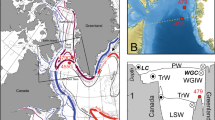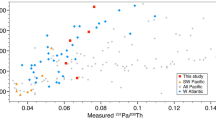Abstract
The strength and geometry of the Atlantic meridional overturning circulation is tightly coupled to climate on glacial–interglacial and millennial timescales1, but has proved difficult to reconstruct, particularly for the Last Glacial Maximum2. Today, the return flow from the northern North Atlantic to lower latitudes associated with the Atlantic meridional overturning circulation reaches down to approximately 4,000 m. In contrast, during the Last Glacial Maximum this return flow is thought to have occurred primarily at shallower depths. Measurements of sedimentary 231Pa/230Th have been used to reconstruct the strength of circulation in the North Atlantic Ocean3,4, but the effects of biogenic silica on 231Pa/230Th-based estimates remain controversial5. Here we use measurements of 231Pa/230Th ratios and biogenic silica in Holocene-aged Atlantic sediments and simulations with a two-dimensional scavenging model to demonstrate that the geometry and strength of the Atlantic meridional overturning circulation are the primary controls of 231Pa/230Th ratios in modern Atlantic sediments. For the glacial maximum, a simulation of Atlantic overturning with a shallow, but vigorous circulation and bulk water transport at around 2,000 m depth best matched observed glacial Atlantic 231Pa/230Th values. We estimate that the transport of intermediate water during the Last Glacial Maximum was at least as strong as deep water transport today.
This is a preview of subscription content, access via your institution
Access options
Subscribe to this journal
Receive 12 print issues and online access
$259.00 per year
only $21.58 per issue
Buy this article
- Purchase on Springer Link
- Instant access to full article PDF
Prices may be subject to local taxes which are calculated during checkout




Similar content being viewed by others
References
Rahmstorf, S. Ocean circulation and climate during the past 120,000 years. Nature 419, 207–214 (2002).
Lynch-Stieglitz, J. et al. Atlantic Meridional Overturning Circulation during the Last Glacial Maximum. Science 316, 66–69 (2007).
Marchal, O., Francois, R., Stocker, T. & Joos, F. Ocean thermohaline circulation and sedimentary 231Pa/230Th ratio. Paleoceanography 15, PA000496 (2000).
Yu, E., Francois, R. & Bacon, M. Similar rates of modern and last-glacial ocean thermohaline circulation inferred from radiochemical data. Nature 379, 689–694 (1996).
Keigwin, D. & Boyle, E. Did North Atlantic Overturning halt 17,000 years ago? Paleoceanography 23, PA1101 (2008).
Curry, W. & Oppo, D. Glacial water mass geometry and the distribution of δ13C of CO2 in the western Atlantic Ocean. Paleoceanography 20, PA1017 (2005).
Boyle, E. & Keigwin, L. North Atlantic thermohaline circulation during the past 20,000 years linked to high-latitude surface temperature. Nature 330, 35–40 (1987).
Marchitto, T. & Broecker, W. Deep watermass geometry in the glacial Atlantic ocean: a review of constraints from the paleonutrient proxy Cd/Ca. Geochem. Geophys. Geosyst. 7, Q12003 (2006).
Burke, A., Marchal, O., Bradtmiller, L., McManus, J. & François, R. Application of an inverse method to interpret 231Pa/230Th observations from marine sediments. Paleoceanography 26, PA1212 (2011).
Kitoh, A., Murakami, S. & Koide, H. A simulation of the Last Glacial Maximum with a coupled atmosphere-ocean GCM. Geophys. Res. Lett. 28, 2221–2224 (2001).
Hesse, T., Butzin, M., Bickert, T. & Lohmann, G. A model-data comparison of δ13C in the glacial Atlantic Ocean. Paleoceanography 26, PA3220 (2011).
McManus, J., Francois, R., Gherardi, J., Keigwin, L. & Brown-Leger, S. Collapse and rapid resumption of Atlantic meridional circulation linked to deglacial climate change. Nature 428, 834–837 (2004).
Gherardi, J. et al. Glacial-interglacial circulation changes inferred from 231Pa/230Th sedimentary record in the North Atlantic region. Paleoceanography 24, PA2204 (2009).
Anderson, R. et al. Wind-driven upwelling in the Southern Ocean and the deglacial rise in atmospheric CO2 . Science 323, 1443–1448 (2009).
Bradtmiller, L., Anderson, R., Fleisher, M. & Burckle, L. Opal burial in the equatorial Atlantic Ocean over the last 30 kyr: Implications for glacial-interglacial changes in the ocean silicon cycle. Paleoceanography 22, PA4216 (2007).
Lippold, J. et al. Does sedimentary 231Pa/230Th from the Bermuda Rise monitor past Atlantic Meridional Overturning Circulation? Geophys. Res. Lett. 36, L12601 (2009).
Hall, I. et al. Accelerated drawdown of meridional overturning in the late-glacial Atlantic triggered by transient pre-H event freshwater perturbation. Geophys. Res. Lett. 33, L16616 (2006).
Guihou, A. et al. Late slowdown of the Atlantic Meridional Overturning Circulation during the Last Glacial Inception: New constraints from sedimentary (231Pa/230Th). Earth Planet. Sci. Lett. 289, 520–529 (2010).
Luo, Y., Francois, R. & Allen, S. Sediment 231Pa/230Th as a recorder of the rate of the Atlantic Meridional Overturning Circulation: Insights from a 2-D model. Ocean Sci. 6, 381–400 (2010).
Lippold, J., Gherardi, J. & Luo, Y. Testing the 231Pa/230Th paleocirculation proxy—A data versus 2D model comparison. Geophys. Res. Lett. 38, L20603 (2011).
Francois, R. Proxies in Late Cenozoic Paleoceanography: Paleoflux and Paleocirculation from Sediment 230Th and 231Pa/230Th Ch. 16 (Elsevier, 2007).
Gherardi, J. et al. Reply to comment by S. Peacock on glacial–interglacial circulation changes inferred from 231Pa/230Th sedimentary record in the North Atlantic region. Paleoceanography 25, PA2207 (2010).
Lippold, J., Mulitza, S., Mollenhauer, G., Weyer, S. & Christl, M. Boundary scavenging at the east Atlantic margin does not negate use of Pa/Th to trace Atlantic overturning. Earth Planet. Sci. Lett. 333–334, 317–331 (2012).
Christl, M. et al. 231Pa/230Th: A proxy for upwelling off the coast of West Africa. Nucl. Instrum. Methods Phys. Res. B 268, 1159–1162 (2009).
Scholten, J. et al. Advection and Scavenging: Effect on 230Th and 230Pa distribution off Southwest-Africa. Earth Planet. Sci. Lett. 271, 159–169 (2008).
Anderson, B., Bacon, M. & Brewer, P. Removal of 230Th and 231Pa at ocean margins. Earth Planet. Sci. Lett. 66, 73–90 (1983).
Talley, L., Reid, J. & Robbins, P. Data-based meridional overturning streamfunctions for the global ocean. J. Clim. 16, 3213–3226 (2003).
Kwon, E. et al. North Atlantic ventilation of southern-sourced deep water in the glacial ocean. Paleoceanography 27, PA2208 (2012).
Acknowledgements
Sediment material for this study was provided by J. Pätzold, the ODP/IODP core repository Bremen, and S. Jaccard. The manuscript benefited from inputs by J-C. Duplessy and C. Waelbroeck. Expertise was provided by M. Andersen, B. Antz, P. Blaser, E. Böhm, M. Christl, E. Christner, M. Deininger, H. Dicht, M. Gutjahr, A. Mangini, S. Rheinberger, M. Ruckelshausen, M. Soon, Q. Supiramaniam, S. Weyer and F. Wombacher. Support for this research was provided by the Deutsche Forschungsgesellschaft, grant Li1815/2 to J.L. and a NSERC Discovery Grant to R.F.
Author information
Authors and Affiliations
Contributions
J.L., Y.L., J.G. and R.F. developed the concept and designed the study. J.L., J.G., S.P. and B.H. performed Pa/Th measurements. J.L., Y.L., R.F. and B.H. performed opal measurements. Y.L., R.F. and S.E.A. developed and applied the model. S.P., J.G., B.H. and H.S. provided sample material and age models. J.L., Y.L. and R.F. wrote the manuscript.
Corresponding author
Ethics declarations
Competing interests
The authors declare no competing financial interests.
Supplementary information
Supplementary Information
Supplementary Information (PDF 1430 kb)
Supplementary Information
Supplementary Information (XLS 88 kb)
Rights and permissions
About this article
Cite this article
Lippold, J., Luo, Y., Francois, R. et al. Strength and geometry of the glacial Atlantic Meridional Overturning Circulation. Nature Geosci 5, 813–816 (2012). https://doi.org/10.1038/ngeo1608
Received:
Accepted:
Published:
Issue Date:
DOI: https://doi.org/10.1038/ngeo1608
This article is cited by
-
Multi-proxy constraints on Atlantic circulation dynamics since the last ice age
Nature Geoscience (2023)
-
Strong temperature gradients in the ice age North Atlantic Ocean revealed by plankton biogeography
Nature Geoscience (2023)
-
Identifying the mechanisms of DO-scale oscillations in a GCM: a salt oscillator triggered by the Laurentide ice sheet
Climate Dynamics (2023)
-
Deglacial patterns of South Pacific overturning inferred from 231Pa and 230Th
Scientific Reports (2021)
-
Adsorption of Th and Pa onto particles and the effect of organic compounds in natural seawater
Journal of Oceanology and Limnology (2021)



